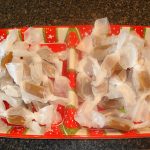Ingredients
Scale
- 1/2 cup butter (not margarine)
- 1 1/2 cups light corn syrup
- 2 cups brown sugar
- 1 1/2 cups heavy whipping cream, divided
- 1–1 1/2 tsp vanilla extract
- mixed nuts, optional
Instructions
- First, butter a 9×13 baking dish. If you want to have nuts in your caramel, you may spread them out in the pan and pour the finished caramel on top of them. Or you can add nuts directly to the caramel just before pouring it out of the pan (see instructions). Set the pan aside.
- Begin by melting butter in large heavy pan over medium-low heat. Add brown sugar, corn syrup, and half of cream (3/4 cup). Cook over medium-low heat, stirring gently, until sugar dissolves.
- Cook, stirring occasionally, until candy thermometer reaches 224°. Add rest of cream (3/4 cup) gradually. Turn up stove to medium heat and continue to cook. At this point I wash down the insides of the pan with a pastry brush and water to get rid of any sugar crystals (left alone they may cause your caramel to turn to sugar). Don’t worry about drops of water getting in the caramel – it will boil off.
- Just before it reaches 240°, add in vanilla. Allow it to come back to a boil and remove from heat as soon as it reaches 240 degrees F.**check tips If you like nuts, add them about 1 minute before the caramel is done – if you add them earlier they will over cook.
- Immediately pour into a buttered 9×13-inch pan. Allow to cool, use a spatula to remove caramel onto a cutting board, and cut caramel into small squares. Wrap in waxed paper or plastic wrap.
Tips
- The trickiest part about making caramel is knowing how high a temperature to let it cook to… remember that the hotter it gets, the harder the caramel will be. I want to caution you all that 240 degrees F is NOT a hard and fast rule – in fact that may only work out for a few of you. Unfortunately there are too many factors contributing for me to be able to tell you an exact temperature: your altitude, your candy thermometer, the type of pot you use, the type of stove top, etc. If you are near sea level, the temperature could be higher than 240, if you are at very high altitude, it could be lower. However, I have to say that the most variation in temperature comes from the candy thermometer! There are two things that you can do to help though.
- Number 1: calibrate your candy thermometer. To do this, look up what temperature water boils at your altitude. Next boil water in your pot with your candy thermometer and note at what temperature it reads when the water boils. This will tell you if your candy thermometer is “off” and by how many degrees. This will help you know if you need to add or subract a certain of degrees in a recipe.
- Number 2 (and most important!): I would suggest checking your caramel the old fashioned way… when it gets close to the temp you think it will be done at, drop a tiny bit into ice water and swirl the water around with a spoon a little. The caramel should harden quickly. If it forms a ball that is the right consistency you like, it’s ready. I like it to form a solid ball that is firm but still be soft enough to squish between your fingers when pressure is applied. This is completely subjective though, which is why this is a great method to get it the way YOU like it!
- Don’t stir it when it gets close to the end. In fact, it needs minimal stirring at all!
- Do not touch or disturb the caramel once you’ve poured it into the 9X13 – wait patiently for it to set up.
- I like to wrap in waxed paper. I rip the paper from the roll in 4 1/2 -5 inch strips then cut those in half. (That’s perfect for a piece ~1 inch square) Then roll the piece of caramel and twist ends. Grip the paper from the far edge to twist in, otherwise it will rip.
